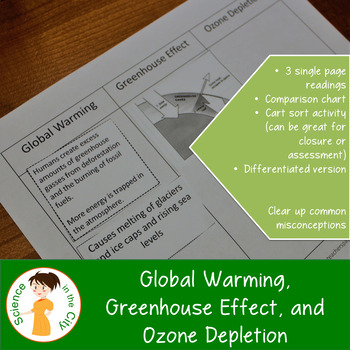Global Warming, Greenhouse Effect, and Ozone Depletion Activity
- PDF
What educators are saying
Also included in
- This MONEY SAVING BUNDLE includes all Earth Science items in my store, now and in the future. All the resources included are shown below, but this bundle includes a full year of warm-up activities, a digital Google Drive activity, a curriculum map/planner, numerous lab activities, a lab rubric, anPrice $88.00Original Price $109.95Save $21.95
Description
Students have many misconceptions about global warming, greenhouse effect, and ozone depletion. This READY TO GO AND FLEXIBLE resource is focused on teaching students the basics of each, and giving them a chance to compare and contrast. From this activity, students should be able to briefly summarize each of these three processes, identify which are natural and which are human-caused, list causes and chemicals involved, and likely effects.
Included are:
- Three one-page readings (one on each topic)
- A chart that students complete about the causes and effects of each process
- A card sort activity (great for closure or quick assessment)
- A modified version of the chart that can be done as a cut and paste activity, or an activity with a word/phrase bank.
You may also be interested in:
Climate Introduction lesson plan and handouts & smartboard file
Entire Earth Science Course Student Keeping Track of Learning and Vocab Lists
★★★★★★★★★★★★★★★★★★★★★
Don't forget that leaving feedback earns you points toward FREE TPT purchases.
Also, follow me and be notified when new products are uploaded.
Please feel free to contact me with any questions.
★★★★★★★★★★★★★★★★★★★★★
JOIN ME:
Science in the City Blog | Instagram | Pinterest | Facebook






